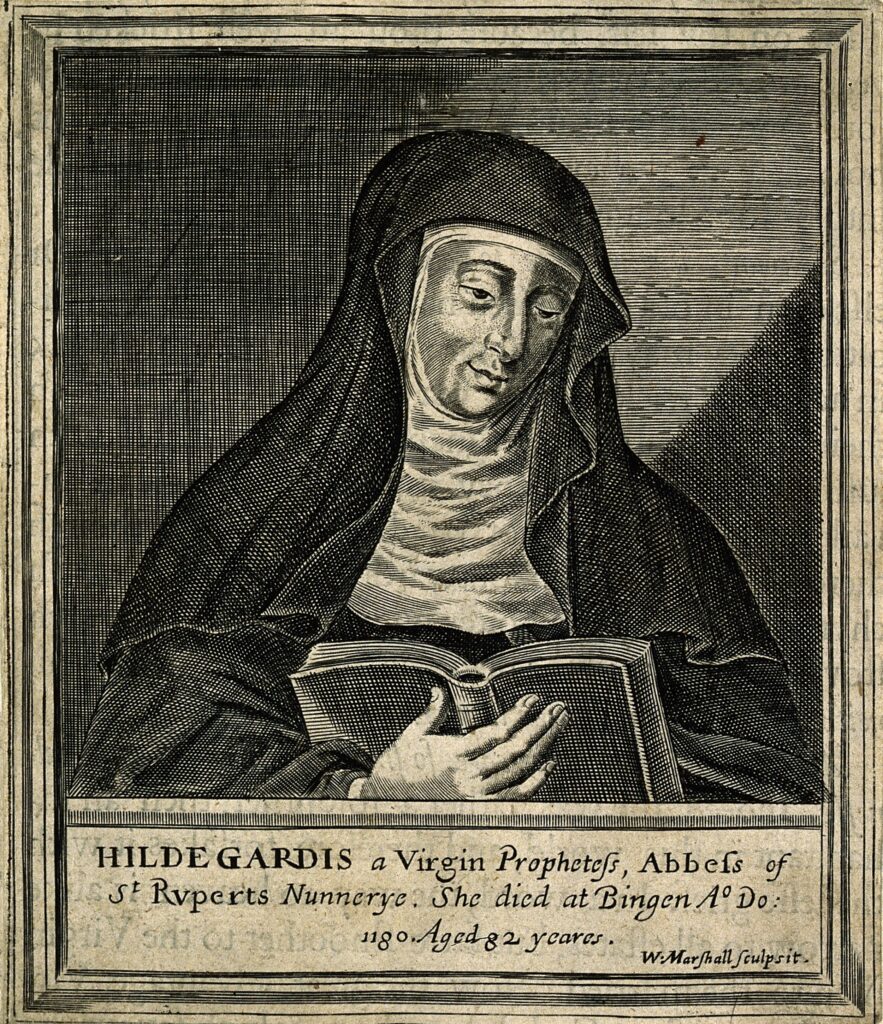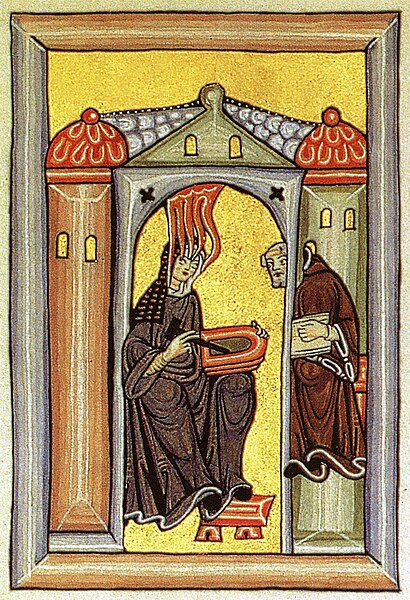The Sibyl of the Rhine

The twelfth-century saint, Hildegard of Bingen, is known today as one of the few prominent women saints in the medieval period, quite renowned for her writing, poetry, and musical works. Born over 900 years ago in 1098, St. Hildegard is also known as Hildegarde, Hildegard von Bingen, or even the Sibyl of the Rhine. She has recently experienced an uptick in popularity among people in both the secular and religious worlds.
Hildegard was born the tenth child of noble parents and placed under the care of a cloister at a young age. At the age of 15 she officially began her life as a nun. Her Benedictine community encouraged its inhabitants to pursue hermetic lives, and Hildegard, like her fellow sisters, spent most of her time alone in meditation, inspired by the mystical tradition. At the age of 38 she worked with a monk to record the spiritual visions she was said to have experienced throughout her life as a nun, resulting in the book Scrivias (1141-52).
In 1147 Hildegard left her original convent in Disibodenberg and founded a new convent. Although she was never formally educated and relied on the help of others to record her words, Hildegard became well regarded by the Church and seen as an advisor and influential voice within Christianity of the time. It was in Hildegard’s new convent that much of her writing developed, especially with her composition of 77 lyric poems, each set to a piece of music. These songs, called Symphonia Armonie Celestium Revelationum, formed a liturgical cycle for the Church year.

These works are what she is still best known for today—fitting since she thought that music was the highest praise to God. She is considered by many to be one of the first identifiable composers in the history of Western music (most medieval composers were anonymous), even as she was just “rediscovered” in the last twenty years.
Her other writings included pieces about the lives of the saints; philosophy; treatises on the importance of natural, herbal medicine and natural history; a musical morality play; and extensive correspondence with those outside the convent, including with St. Bernard of Clairvaux. It was also in this period that she began to travel more widely across Germany, evangelizing large groups of people and sharing her religious insights.
Hildegard died in 1179 in the monastery she founded in the area of Bingen. When she died she was known and beloved throughout medieval Europe, though her prolific writing was not distributed until long after her death. Much of our knowledge about Hildegard comes from the biographies of two monks who followed her, Godefrid and Theodoric.
A Brief History
As with other women who held a prominent place within the arc of the history of the medieval period of Christendom, it is important to ask what this saint has to do with Lutheranism today. While her day is commemorated on September 17th and included within Loehe’s Lutheran martyrology, it is not part of the LSB’s current sanctoral calendar published in the Lutheran Church—Missouri Synod’s hymnal.
First, St. Hildegard was highly influential in the evolution of Church music, something about which Lutherans are very concerned. Up until her life, the primary form of vocal sacred music was plainchant (also known as plainsong or Gregorian chant)—a melismatic, fluid, mostly stepwise melodic and unaccompanied music intended to turn the mind and spirit toward God. Hildegard’s music, though, often disregarded the rules of this style, making previously unheard leaps between notes and evincing a type of “fluidity” that would influence later Lutheran composers who also desired to move away from the Church’s previous musical inclinations.
Second, and as previously mentioned, Hildegard was extremely influential during her time, known and beloved by many others in the Church who paved the way for the later Reformation. Her name is certainly worth knowing, and the recent resurgence of her popularity is well founded. For this reason alone her day is worth celebrating, and it may well be a good thing for her to be a better known saint within Lutheran circles!

Collect
Hear us, O God, our Savior: so that we, who rejoice in the feast of Blessed Hildegard, may learn from her the spirit of loving devotion; through Jesus Christ, Thy Son, our Lord, who liveth and reigneth with Thee and the Holy Ghost: ever one God, world without end. Amen.
Lessons
Resources
Propers found in Daily Divine Service Book: A Lutheran Daily Missal, edited by the Rev. Heath Curtis
References:
1. Ross, Alex. “Hildegard of Bingen Composes the Cosmos.” January 30, 2023. The New Yorker.
2. Hopkin, Owen. “Hildegard of Bingen: life and music of the great female composer.” Classic FM.
Images:
1. Hildegard von Bingen, W. Marshall, England, ca. 17th century.
2. Hildegard von Bingen receives a divine inspiration and passes it on to her scribe, from Scrivas, Unknown, Germany, ca. 12th century.
3. Hildegard von Bingen, from Scrivas, Unknown, Germany, ca. 12th century.



[…] St. Hildegard of Bingen dabbled in many areas of intellectual inquiry, always seeking to make different connections between her varied loves for religion, spirituality, science, nature, botany, nutrition, herbs, medicine, and music. In her Physica: Liber Simplicis Medicine as well as her Liber Divinorum Operum, the final text that she wrote, she especially focused on the ways that these subjects related to the holistic healing of the body. Part of this included her creation of different medieval recipes that she thought helped support the body in health and wellness. […]